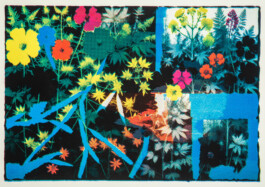
Size: 70x50 cm
Technique: Four-color screen print
Edition: 5+1 AP
"Neophytes" is a four-color screen print that delves into the complexities of migration, using the natural metaphor of plant species adapting to new environments. This artwork portrays the intricate interplay between the old and the new, illustrating how diverse elements integrate into established systems. Serving as the inaugural piece in a series that will span various formats and delve deeper into the theme of neophytes, it sets the stage for a broader exploration of these concepts.
Drawing inspiration from Charles Baudelaire's famous poetry collection "Les Fleurs du Mal" (1857), "Neophytes" symbolizes the "Flowers of Evil." The almost closed square in the composition acts as a symbolic barrier or social structure that migrants encounter, with its slight opening suggesting the limited opportunities that are accessible to newcomers. This element encourages contemplation on the challenges of partial integration and raises questions about the impacts of acculturation and assimilation.
Plants of Evil
From September 1, 2024, certain invasive alien plants (neophytes) will no longer be allowed to be marketed in Switzerland. Similarly, the European Union regularly expands the list of plants that can harm biodiversity. The work invites viewers to reflect on themes such as cultural diversity, adaptation, and the ongoing changes in our increasingly globalized society.
"Neophytes" not only draws parallels between plant species and human migrants, but also emphasizes the resilience and tenacity required to thrive in new environments. By focusing on the natural world's response to change, the artwork subtly underscores the broader human experience of displacement and adaptation.
The "Neophytes" series aims to explore these themes across various media, including screenprint, woodcut, and filmic works. Each piece will build upon the previous one, creating a comprehensive narrative that addresses the multifaceted nature of migration and integration. My choice to begin with a screen print highlights the traditional roots of printmaking while also pushing the boundaries of contemporary art practices.
Inspired by Baudelaire's "Les Fleurs du Mal," the artwork connects the past with the present and draws on the timeless themes of beauty, suffering, and transformation. Baudelaire's poetry, much like the "Neophytes" series, delves into the human condition, exploring the tensions between the familiar and the foreign, the accepted and the ostracized.
"Neophytes" challenges its audience to consider the broader implications of migration, not only as a physical journey but also as a profound cultural and emotional experience. In an increasingly interconnected world, "Neophytes" stands as a poignant reminder of the ongoing need for empathy, understanding, and the celebration of diversity.
《新生者》是一幅四色丝网印刷作品,通过植物物种适应新环境的自然隐喻,深入探讨了迁徙的复杂性。这件艺术作品描绘了新旧元素之间复杂的相互作用,展示了不同元素如何融入现有系统。作为一个将涵盖各种格式并深入探讨新生者主题的系列的首件作品,它为这些概念的更广泛探索奠定了基础。
《新生者》从查尔斯·波德莱尔著名的诗集《恶之花》(1857)中汲取灵感,象征着“恶之花”。构图中几乎封闭的方形象征了迁徙者所遇到的社会结构或障碍,其略微开启的部分暗示了新来者可以获得的有限机会。这个元素引发了对部分融入的挑战的思考,并提出了关于文化适应和同化影响的问题。
在瑞士被禁止的《新生者》,邀请观众反思文化多样性、适应性和在我们日益全球化的社会中持续变化的主题。
《新生者》不仅描绘了植物物种与人类迁徙者之间的平行关系,还强调了在新环境中茁壮成长所需的韧性和坚毅。通过关注自然界对变化的反应,这件艺术品巧妙地突显了更广泛的人类流离失所和适应的经历。丝网印刷中精心的细节和生动的色彩吸引了观众的注意,鼓励人们更深入地了解这一主题。
《新生者》所属的系列旨在通过数字艺术、装置艺术和混合媒体等多种媒介来探索这些主题。每件作品都会在前一件作品的基础上继续创作,形成一个全面的叙述,阐述迁徙和融合的多方面性质。艺术家选择从丝网印刷开始,突出了版画艺术的传统根源,同时也推动了当代艺术实践的界限。
通过引用波德莱尔的《恶之花》,这件艺术作品将过去与现在联系起来,探讨了美、痛苦和转变的永恒主题。波德莱尔的诗歌与《新生者》系列一样,深入探讨了人类状况,探索了熟悉与陌生、被接受与被排斥之间的紧张关系。这种互文性丰富了观众的理解,提供了一种跨越文学和视觉艺术的多层次解释。
《新生者》挑战观众思考迁徙的更广泛意义,不仅是一次身体上的旅程,更是一种深刻的文化和情感体验。这件艺术作品在瑞士的禁令增加了一层额外的吸引力,促使人们对审查制度、文化接受度和艺术在激发思考和对话中的力量提出疑问。在一个日益互联的世界中,《新生者》作为一个深刻的提醒,提醒人们持续需要同情、理解和庆祝多样性。

Size: 70x50 cm
Technique: Four-color screen print
Edition: 5+1 AP
"Neophytes" is a four-color screen print that delves into the complexities of migration, using the natural metaphor of plant species adapting to new environments. This artwork portrays the intricate interplay between the old and the new, illustrating how diverse elements integrate into established systems. Serving as the inaugural piece in a series that will span various formats and delve deeper into the theme of neophytes, it sets the stage for a broader exploration of these concepts.
Drawing inspiration from Charles Baudelaire's famous poetry collection "Les Fleurs du Mal" (1857), "Neophytes" symbolizes the "Flowers of Evil." The almost closed square in the composition acts as a symbolic barrier or social structure that migrants encounter, with its slight opening suggesting the limited opportunities that are accessible to newcomers. This element encourages contemplation on the challenges of partial integration and raises questions about the impacts of acculturation and assimilation.
Plants of Evil
From September 1, 2024, certain invasive alien plants (neophytes) will no longer be allowed to be marketed in Switzerland. Similarly, the European Union regularly expands the list of plants that can harm biodiversity. The work invites viewers to reflect on themes such as cultural diversity, adaptation, and the ongoing changes in our increasingly globalized society.
"Neophytes" not only draws parallels between plant species and human migrants, but also emphasizes the resilience and tenacity required to thrive in new environments. By focusing on the natural world's response to change, the artwork subtly underscores the broader human experience of displacement and adaptation.
The "Neophytes" series aims to explore these themes across various media, including screenprint, woodcut, and filmic works. Each piece will build upon the previous one, creating a comprehensive narrative that addresses the multifaceted nature of migration and integration. My choice to begin with a screen print highlights the traditional roots of printmaking while also pushing the boundaries of contemporary art practices.
Inspired by Baudelaire's "Les Fleurs du Mal," the artwork connects the past with the present and draws on the timeless themes of beauty, suffering, and transformation. Baudelaire's poetry, much like the "Neophytes" series, delves into the human condition, exploring the tensions between the familiar and the foreign, the accepted and the ostracized.
"Neophytes" challenges its audience to consider the broader implications of migration, not only as a physical journey but also as a profound cultural and emotional experience. In an increasingly interconnected world, "Neophytes" stands as a poignant reminder of the ongoing need for empathy, understanding, and the celebration of diversity.
《新生者》是一幅四色丝网印刷作品,通过植物物种适应新环境的自然隐喻,深入探讨了迁徙的复杂性。这件艺术作品描绘了新旧元素之间复杂的相互作用,展示了不同元素如何融入现有系统。作为一个将涵盖各种格式并深入探讨新生者主题的系列的首件作品,它为这些概念的更广泛探索奠定了基础。
《新生者》从查尔斯·波德莱尔著名的诗集《恶之花》(1857)中汲取灵感,象征着“恶之花”。构图中几乎封闭的方形象征了迁徙者所遇到的社会结构或障碍,其略微开启的部分暗示了新来者可以获得的有限机会。这个元素引发了对部分融入的挑战的思考,并提出了关于文化适应和同化影响的问题。
在瑞士被禁止的《新生者》,邀请观众反思文化多样性、适应性和在我们日益全球化的社会中持续变化的主题。
《新生者》不仅描绘了植物物种与人类迁徙者之间的平行关系,还强调了在新环境中茁壮成长所需的韧性和坚毅。通过关注自然界对变化的反应,这件艺术品巧妙地突显了更广泛的人类流离失所和适应的经历。丝网印刷中精心的细节和生动的色彩吸引了观众的注意,鼓励人们更深入地了解这一主题。
《新生者》所属的系列旨在通过数字艺术、装置艺术和混合媒体等多种媒介来探索这些主题。每件作品都会在前一件作品的基础上继续创作,形成一个全面的叙述,阐述迁徙和融合的多方面性质。艺术家选择从丝网印刷开始,突出了版画艺术的传统根源,同时也推动了当代艺术实践的界限。
通过引用波德莱尔的《恶之花》,这件艺术作品将过去与现在联系起来,探讨了美、痛苦和转变的永恒主题。波德莱尔的诗歌与《新生者》系列一样,深入探讨了人类状况,探索了熟悉与陌生、被接受与被排斥之间的紧张关系。这种互文性丰富了观众的理解,提供了一种跨越文学和视觉艺术的多层次解释。
《新生者》挑战观众思考迁徙的更广泛意义,不仅是一次身体上的旅程,更是一种深刻的文化和情感体验。这件艺术作品在瑞士的禁令增加了一层额外的吸引力,促使人们对审查制度、文化接受度和艺术在激发思考和对话中的力量提出疑问。在一个日益互联的世界中,《新生者》作为一个深刻的提醒,提醒人们持续需要同情、理解和庆祝多样性。